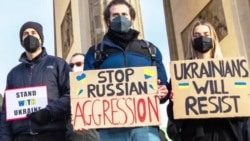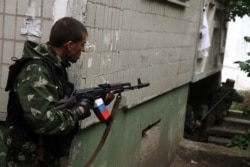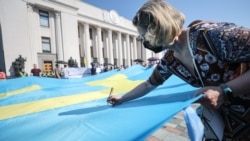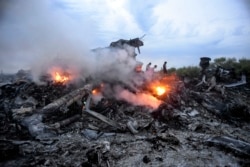On February 13, RT Editor-in-Chief Margarita Simonyan appeared on the “Evening With Vladimir Solovyov” political talk show to deflect allegations that Russia plans a large-scale invasion of Ukraine.
Simonyan argued that it is incorrect to ask whether Russia will invade Ukraine:
“I am absolutely convinced that Russia is not going to start a war with Ukraine, and this will not happen in any way. And if Russia is compelled to interfere with what’s happening in Ukraine, [it will only be] with the goal of ending the war in Ukraine, not to start a war in Ukraine.”
Simonyan claimed that Ukraine has been waging a war against its own people for eight years, killing thousands of civilians. Thousands of children who had “their arms and legs torn off” were “buried in small coffins,” she said.
She used inflammatory language to argue for a humanitarian intervention:
“Russia cannot but stop this war. What are we waiting for? For when camps are organized there? For when they are gassing their own people?”
Simonyan’s comments came after Jake Sullivan, the White House national security adviser, warned a Russian invasion could be imminent.
The United States has begun evacuating embassy staff, while some airlines are halting flights to Ukraine, or diverting them to other destinations.
Ukrainian President Volodymyr Zelensky said the invasion would happen on February 16, only to walk that statement back.
Simonyan’s remarks are misleading or false.
In fact, Russia has already invaded Ukraine – in 2014. The question today is whether the 130,000 troops positioned near Ukraine’s borders are poised to further invade.
Russia has long tried to paint the conflict it initiated in the Eastern Donbas region as a civil war. But Russia instigated the conflict there and perpetuates it.
Russia’s invasion of Ukraine began on February 26, 2014, when Russia-backed forces established a military checkpoint in Crimea on the road from the port city of Sevastopol to Crimea’s capital Simferopol.
The following day, Russian special forces, operating without national insignia, seized the Crimean parliament building in Simferopol and raised the Russian flag. The incursion by the so-called “little green men” resulted in Russian forces taking control of the peninsula.
Despite initial denials, Russian President Vladimir Putin has admitted that Russian forces invaded the peninsula, saying “our troops stood behind Crimea’s self-defense forces.”
Russia attempted to justify its illegal annexation of Crimea with the false claim that the peninsula’s population “was threatened with extermination and voted for reunion with Russia.”
Russia has never presented evidence Crimeans were faced with extermination following the February 2014 revolution, which saw then Ukrainian president Viktor Yanukovych flee the country.
While protests for and against the so-called Maidan revolution were held in Crimea, there are no reports of state-sponsored violence or repression at that time, let alone proof of "extermination."
By contrast, following Russia's annexation of Crimea, members of the largely Muslim, Turkic-speaking indigenous Tatar ethnic group have reportedly faced abuse, discrimination and suppression.
Russia denies it deployed troops to eastern Ukraine to back pro-Russian separatists, some of whom were linked to Russian intelligence. Armed conflict broke out there in April 2014.
The evidence says otherwise.
As Polygraph.info previously reported, in November 2021, a court in Russia's Rostov oblast, near the occupied part of Donbas, issued a verdict in a bribery case.
It found that V.N. Zabaluev, who managed a firm which supplied food to Russian troops deployed in the “Donetsk People's Republic" (DNR) and “Luhansk People's Republic” (LNR), Russia's two puppet states in Donbas, had paid bribes to military officers.
Russian soldiers have posted photographs on social media admitting they were operating inside Ukraine, attacking Ukraine and transporting weapons to Ukraine.
Other evidence showing that Russian forces have been operating in Ukraine includes video interviews with Russian troops captured inside Ukraine, memorial notices on social media of Russian soldiers who died in Ukraine, an unexplained increase in wounded and dead Russian troops, and the provision of death and disability benefits to Russian soldiers and their families.
The so-called “separatist” forces in eastern Ukraine have Russian-made weapons and equipment that were never exported to Ukraine or used by Ukraine’s armed forces.
A three-year study by the U.K.-based investigative organization Conflict Armament Research found “that factories based in what is today the Russian Federation produced most of the militias’ ammunition and nearly all their weapons, from assault rifles and precision rifles, grenade launchers, precision-guided munitions, and landmines to anti-tank guided weapons.”
The “pro-Russian fighters” in eastern Ukraine are using arms and sophisticated weapons systems that were not purchased by Ukraine’s military and therefore could not have been looted. The weapons systems include modern battle tanks with trained crews.
An international investigation team found that a Buk-TELAR missile system, brought into Ukraine from Kursk, Russia, by the Russian army’s 53rd Anti-Aircraft Missile Brigade, was used to shoot down Malaysia Airlines flight 17 over eastern Ukraine on July 17, 2014. That attack killed all 298 people on board.
Igor Girkin, a.k.a. Strelkov, formally a senior commander of Russia’s forces in Donbas in 2014, is one of four individuals on trial in absentia at the Hague District Court for his alleged role in shooting down MH17.
The day MH-17 was shot down, a social media account associated with Girkin bragged about downing a Ukrainian military An-26 cargo plane in the vicinity of MH17’s crash site.
As Polygraph.info has reported, the post was taken down after it became clear that a passenger airliner, MH17, had been shot down, not a Ukrainian cargo plane. However, Russia’s TASS news agency still has a story online reporting that pro-Russian forces “brought down” an An-26 on the outskirts of the town of Torez, close to where MH17 was shot down.
On July 14, 2014, Ukrainian officials said an An-26 was shot down by a surface-to-air missile over eastern Ukraine. But there is no record of an An-26 being shot down on July 17.
Girkin has claimed that the hostilities in eastern Ukraine would have fizzled out had his unit not invaded.
Girkin, who was also a leading “self-defense” commander in Crimea, admitted in a 2015 interview that Crimean parliament members were forced at gunpoint to support Russia’s annexation of the peninsula.
Meantime, Simonyan’s reference to murdered children and the potential of a Holocaust-like scenario playing out are staples of Russian propaganda.
In July 2014, Russian state media ran the false story that Ukrainian soldiers had tortured and crucified a 3-year-old boy in Slovyansk, Ukraine.
In April 2021, Russian media falsely claimed that a Ukrainian drone had killed a child in Oleksandrivsk, a small city in Luhansk, Ukraine.
Russian state media have systematically portrayed Ukraine’s government as a “fascist junta” and regularly play up fears of a Nazi threat in Ukraine.
Russian Foreign Minister Sergey Lavrov recently called statements by his Ukrainian counterpart, Dmitry Kuleba, propaganda from “the school of Goebbels” that “maybe even surpasses the art of the chief propagandist of the Third Reich.”
In a piece published in 2016 by the Washington D.C.-based Center for European Policy Analysis, Edward Lucas and Peter Pomeranzev wrote that Kremlin propagandists “exploit the legacy of World War II” and Russia’s historical trauma to spread the false idea that “everyone who opposes Russia now is a fascist.”










